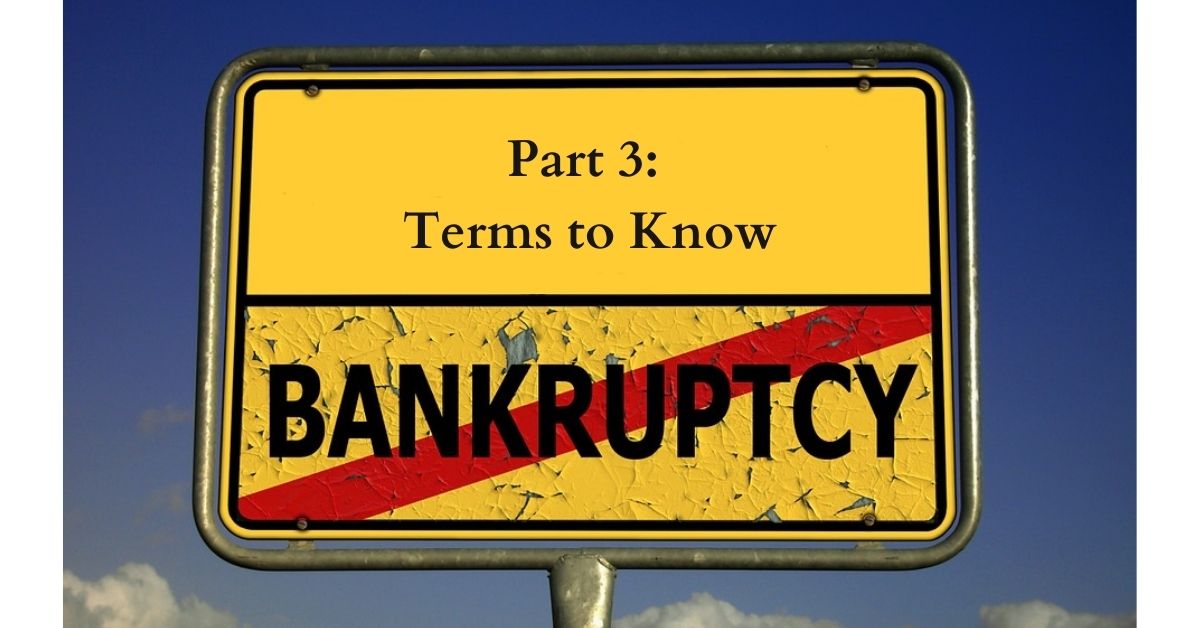Condominiums, Homeowners’ Associations and Bankruptcy: What is an “Automatic Stay” and Other Terms You Need to Know

In the last installment of this series, I explained that Bankruptcy is a federal law designed to help people who owe money get a fresh start. In this part, I want to explain some terms that are helpful to remember.
These are going to be the way that I think of the terms – in plain English. If you want to see the definitions in the official United States Bankruptcy Code, you can look here.
-
- Debtor – The person who files for Bankruptcy. If they are spouses, they are “co-Debtors.”
- Creditor – Someone who the Debtor owes money.
- Secured Creditor –A debt that is backed up by Collateral. If the Debtor does not pay, the Secured Creditor has the right to come and take the Collateral. These are usually things like car loans and mortgages.
- Unsecured Creditor –A debt that is not backed up by any Collateral. Think credit card bills and medical expenses.
- Chapter 7 Bankruptcy – A”liquidation” Bankruptcy. Basically, the Trustee takes all of the Debtor’s stuff and sells it. Then the Trustee distributes the money to the Creditors. Usually, there is not nearly enough stuff to pay off all (or any) of the Creditors. Otherwise, the Debtor would not file for Chapter 7 Bankruptcy.
- Chapter 13 Bankruptcy – This allows the Debtor to “adjust” his or her debts. The Debtor creates a Chapter 13 Plan. This Plan takes all of the Disposable Income of the Debtor and distributes it to the Creditors. Some Creditors get paid in full. Other Creditors get a small part of the debt or nothing at all.
- Chapter 13 Plan – In a Chapter 13 Bankruptcy, the Plan lists all of the Creditors and says how much they will get paid. The Debtor pays the Trustee every month, and the Trustee pays Creditors according to what is in the Chapter 13 Plan. The Chapter 13 Plan can last for up to 5 years.
- Petition Date – The date that the Debtor filed for Bankruptcy. This applies to Chapter 7 and Chapter 13 Bankruptcies. The Petition Date is important because the Debtor’s debt is frozen as of the Petition Date.
- Pre-Petition Debt – All of the debt that the Debtor had on the Petition Date.
- Post-Petition Debt – All of the debt that the Debtor incurs after the Petition Date. So for assessments, the account balance on the Petition Date is the Pre-Petition Debt. All of the assessments, costs, fees, interest, etc. after the Petition Date is Post-Petition Debt.
- Proof of Claim – Creditors file a Proof of Claim that shows how much Pre-Petition Debt they are owed.
- Trustee –The person who is in charge of the Debtor’s Bankruptcy. The Bankruptcy Court appoints the Trustee. In a Chapter 7 Bankruptcy, the Trustee is the person who liquidates the Bankruptcy Estate. In a Chapter 13 Bankruptcy, the Trustee reviews the Plan, receives monthly payments from the Debtor and pays Creditors.
- Bankruptcy Estate – All of the Debtor’s stuff. It includes items the Debtor has on the Petition Date plus certain things that the Debtor gets after the Petition Date.
- Disposable Income – In a Chapter 13 Bankruptcy, this is how much money the Debtor has left over each month after they pay all of their living expenses. The Disposable Income is supposed to go to pay Creditors.
- Confirmation – In a Chapter 13 Bankruptcy, this is when the Bankruptcy Court approves the Debtor’s Plan.
- Discharge – At the end of Bankruptcy, the Debtor gets some of their debts wiped out. In a Chapter 7 Bankruptcy, the Discharge comes when the Bankruptcy Estate is liquidated. In a Chapter 13 Bankruptcy, the Discharge comes when the Plan is over.
- Automatic Stay – When a Debtor files for Bankruptcy, they are protected by the Automatic Stay. This means that the Creditor cannot take any action to pursue a Debt or take any of the Bankruptcy Estate. We are going to cover the Automatic Stay in much more detail in the next installment of the series.
These are the terms that I use the most with Boards and Property Managers when a Unit Owner files for Bankruptcy. I hope that this article is one that you can come back to when trying to collect assessments from a Unit Owner who has filed for Bankruptcy.
In my next installment, I will explain how an Automatic Stay creates a force field around a Debtor. I will talk about the bad things that can happen to Associations if they try to penetrate it and will share the only real way to get through it.
Part I: How Does a Unit Owner Bankruptcy Affect Collections?
